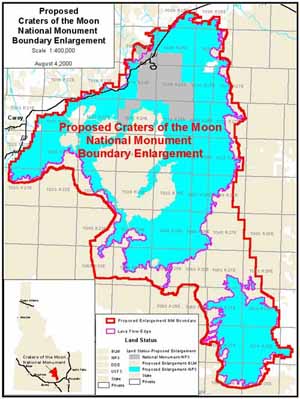Craters expansion finalized
Monument grows by 600,000 acres
By GREG STAHL
Express Staff Writer

President Bill Clinton signed a proclamation Thursday expanding the
Craters of the Moon National Monument, east of Carey, by more than 600,000 acres.
The action enlarges the national monument to include the 62-mile-long
Great Rift, a geologic span of crumpled volcanic lava flows and sweeping sagebrush plains.
The area will be protected from natural resource exploitation, development and public road
building, though it was not established to specifically protect it from any one danger.
The Great Rift runs from near Arco on the north to Minidoka on the south.
Clinton signed the proclamation along with another that extended national
monument status to 293,000 acres of the Colorado Plateau in northern Arizona. The Arizona
area is now called Vermillion Cliffs National Monument.
"With these proclamations, this administration continues its
commitment to preserving and restoring America’s natural treasures, from the Florida
Everglades to the California redwoods, for this and future generations," Clinton said
in a Thursday statement.
The federal Antiquities Act authorizes the president to declare by public
proclamation "historic landmarks, historic and prehistoric structures, and other
objects of historic or scientific interest that are situated upon the lands owned or
controlled by the government of the United States to be national monuments…"
Clinton’s proclamation expands the Craters of the Moon National
Monument to 661,000 acres from 54,000 acres, a 12-fold increase. The monument’s lava
flows will be managed by the National Park Service, while the sage lands in between will
continue to be managed by the U.S. Bureau of Land Management.
Conservationists are applauding the action, while Idaho’s
congressional delegation and Gov. Dirk Kempthorne are condemning a designation they say
left the public out of the process.
"Certainly, what was suggested as the process was never really
followed through as the process," Kempthorne’s press secretary Mark Snyder said.
"After a number of meetings, it appears that there were still concerns that those
folks have that were not addressed, and the administration has [made] a unilateral
decision anyway."
Snyder said the Antiquities Act should not have been used to "bypass
the will of the people and to bypass Congress," a complaint that also resonates from
Idaho’s congressional delegation.
"We are very disturbed by your effort to accomplish this land lockup
without providing proper public process, and once again bypassing Congress," the
Idaho delegation wrote to Interior secretary Bruce Babbitt on May 17. "We urge you to
provide a more open dialogue with the people of Idaho and the Congressional Delegation on
this or any proposal affecting Idaho."
Sen. Larry Craig, R-Idaho, who opposed the plan from the start, held a
hearing on the proposal in Twin Falls last spring. Mike Tracy, Craig’s communications
director, said Clinton didn’t even inform them last week of his intention to sign the
proclamation.
"There was no public process," Tracy said in a statement.
In April 2000, Clinton and Babbitt made public their plans to consider
expanding the national monument. On Aug. 11, after holding hearings with several local
ranchers, Babbitt forwarded a recommendation for expansion to the President.
Jim Morris, Craters superintendent, said ranching, hunting and predator
control will continue within the monument’s boundaries in areas managed by the BLM.
Hunting, ranching and predator control will not be allowed in the Park Service-managed
areas.
Morris said a lengthy planning process will soon begin "to get some
sense of the vision we and the public share for the monument."
Park visitation will probably increase modestly, he said, and staff and
overhead at the park will increase modestly to adequately cater to the larger area and
expected increases in visitation.
The expanded designation will also preclude mineral extraction from within
the monument’s boundaries.
Craters of the Moon holds the most diverse and youngest part of the lava
terrain that covers the southern Snake River Plain. The most recent eruptions at Craters
of the Moon took place about 2,100 years ago.
The volcanic fields are now dormant.
In their heyday, however, some of the lava flows traveled as far as 43
miles from their vents, and some flowed around areas of higher ground and rejoined
downstream to form isolated islands of older terrain that were surrounded by new lava.
These areas are called "kipukas," Hawaiian for windows.
The kipukas are overgrown with plant communities that have been erased
from most of the Great Rift. Protected behind ramparts of lava, man, cattle and invading
winds often couldn’t penetrate the areas.
Kipukas represent some of the last nearly pristine and undisturbed
vegetation on the Snake River Plain, including 700-year-old juniper trees and mature
sagebrush environments.
Since 1906, when Congress passed the Antiquities Act, more than 100
monuments have been designated in 24 states and the Virgin Islands, protecting some 70
million acres, about 10 percent of all federal lands.